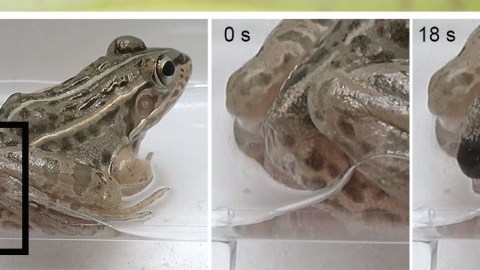Weird science shows unseemly way beetles escape after being eaten

- A Japanese scientist shows that some beetles can wiggle out of frog’s butts after being eaten whole.
- The research suggests the beetle can get out in as little as 7 minutes.
- Most of the beetles swallowed in the experiment survived with no complications after being excreted.
In what is perhaps one of the weirdest experiments ever that comes from the category of “why did anyone need to know this?” scientists have proven that the Regimbartia attenuata beetle can climb out of a frog’s butt after being eaten.
The research was carried out by Kobe University ecologist Shinji Sugiura. His team found that the majority of beetles swallowed by black-spotted pond frogs (Pelophylax nigromaculatus) used in their experiment managed to escape about 6 hours after and were perfectly fine.
“Here, I report active escape of the aquatic beetle R. attenuata from the vents of five frog species via the digestive tract,” writes Sugiura in a new paper, adding “although adult beetles were easily eaten by frogs, 90 percent of swallowed beetles were excreted within six hours after being eaten and, surprisingly, were still alive.”
One bug even got out in as little as 7 minutes.
Sugiura also tried putting wax on the legs of some of the beetles, preventing them from moving. These ones were not able to make it out alive, taking from 38 to 150 hours to be digested.
Naturally, as anyone would upon encountering such a story, you’re wondering where’s the video. Thankfully, the scientists recorded the proceedings:
A beetle species can escape from the vent of a frog / マメガムシはカエルに食べられてもお尻の穴から生きて脱出できるwww.youtube.com
The Regimbartia attenuata beetle can be found in the tropics, especially as pests in fish hatcheries. It’s not the only kind of creature that can survive being swallowed. A recent study showed that snake eels are able to burrow out of the stomachs of fish using their sharp tails, only to become stuck, die, and be mummified in the gut cavity. Scientists are calling the beetle’s ability the first documented “active prey escape.” Usually, such travelers through the digestive tract have particular adaptations that make it possible for them to withstand extreme pH and lack of oxygen. The researchers think the beetle’s trick is in inducing the frog to open a so-called “vent” controlled by the sphincter muscle.
“Individuals were always excreted head first from the frog vent, suggesting that R. attenuata stimulates the hind gut, urging the frog to defecate,” explains Sugiura.
For more information, check out the study published in Current Biology.





